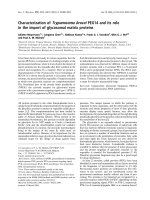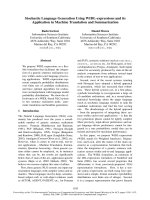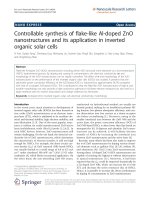Fabrication of polyacrylamide micro pillars and its application in microarray analysis
Bạn đang xem bản rút gọn của tài liệu. Xem và tải ngay bản đầy đủ của tài liệu tại đây (2.38 MB, 86 trang )
FABRICATION OF POLYACRYLAMIDE
MICRO-PILLARS AND ITS APPLICATION IN
MICROARRAY ANALYSIS
EZREIN SHAH SELAMAT
(B.Eng.(Hons.), NUS)
A THESIS SUBMITTED
FOR THE DEGREE OF MASTER OF ENGINEERING
DEPARTMENT OF CIVIL ENGINEERING
NATIONAL UNIVERSITY OF SINGAPORE
2007
ACKNOWLEDGEMENTS
I would like to extend my thanks and appreciation to all that have made this study
possible. I would like specially to express my sincere thanks and gratitude to my research
supervisor Prof Liu Wen-Tso for his support and guidance throughout this study as well
as his encouragement and suggestions.
I would also like to personally thank Hong Peiying, Johnson Ng and all my colleagues in
the lab for their continuous support and understanding.
Heartfelt thanks are also due to all the Environmental Laboratory staff especially Ms.
Sally Toh and Mr. Chandra for their kind assistance in laboratory work and tests and to
all final year students who have helped in completing this project one way or the other.
I am grateful to my parents and family for their encouragement and support and God for
sustaining me throughout this period of hardship.
i
________________________________________________________________________
TABLE OF CONTENTS
________________________________________________________________________
ACKNOWLEDGEMENT
i
TABLE OF CONTENTS
ii
SUMMARY
vi
NOMENCLATURE
viii
LIST OF TABLES
ix
LIST OF FIGURES
x
CHAPTER ONE: INTRODUCTION
1.1
DNA microarray technology
1
1.1.1 What is DNA microarray?
1
1.1.2
3
Gel microarray technology
1.2
Project objectives
5
1.3
Scope of study
5
CHAPTER TWO: LITERATURE REVIEW
2.1
Applications of microarrays
6
2.2
Microarray formats
8
2.2.1
9
Different slide formats
ii
2.2.2
Surface chemistries
10
2.3
Polyacrylamide gel fabrication
12
2.4
Advantages and drawbacks of planar and gel platform
12
2.5
Probe immobilization
14
2.6
Spot morphology
16
2.7
Theoretical analysis of hybridization kinetics
17
2.8
Dissociation studies
2.8.1
Non-equilibrium approach
18
2.8.2
Dissociation temperature, Td
19
2.8.3
Discrimination index, DI
20
2.9
Image analysis software
20
2.10
Data normalization
22
2.11
Artificial Neural Network, NN
23
2.12
Limitations in microarray measurements
24
2.13
Quality control for microarray experiments
25
CHAPTER THREE: MATERIALS AND METHODS
3.1
Overview of microarray set-up
3.2
Coating of glass slides
3.3
27
3.2.1
Application of bind silane to slides
29
3.2.2
Application of repel silane to mask
29
Microchip fabrication
3.3.1
Photopolymerization of polyacrylamide gels
30
iii
3.4
Pre-processing of microchip
31
3.5
Experimental procedures and probe sequences
32
3.6
Dispensing of probes
36
3.7
Post-processing of microchip
36
3.8
Chip hybridization and real-time monitoring
37
3.9
Data analysis
40
3.10
Image acquisition of micro-pillars
3.10.1 Confocal laser scan image
40
3.10.2 Field Emission Scanning Electron Microscopy (FESEM)
scan image
40
CHAPTER FOUR: RESULTS
4.1
Fabrication of micro-pillars
42
4.1.1
42
Structure of gel micro-pillars
4.2
Spot morphology and fluorescence intensity profile
44
4.3
Correlation between effective surface area and signal intensity
46
4.4
Screening of chip
47
4.5
Real-time hybridization monitoring
49
4.6
Dissociation curve analysis using 18-, 35- and 70-mer targets
53
4.7
Functionality of micro-pillars in microarray analysis
56
CHAPTER 5: DISCUSSIONS
5.1
Improving diffusivity
61
5.2
Increasing signal intensity
62
iv
5.3
Discrimination power
63
5.4
SNP genotyping
64
CHAPTER 6: CONCLUSIONS
6.1
Conclusion
65
6.2
Recommendations for future works
66
6.2.1
Optimization of microarray protocol
66
6.2.2
Microfluidic application
67
6.2.3 Expansion of SNP study
68
REFERENCES
69
v
________________________________________________________________________
SUMMARY
DNA microarray technology has become a powerful tool for studying gene
expression and regulation on a genomic scale as well as detecting genetic polymorphisms
in both eukaryotes and prokaryotes. Compared to the conventional membrane
hybridization, microarrays offer the additional advantages of rapid detection, low
background fluorescence, high throughput capabilities and lower cost. However,
microarray analysis of environmental samples faces several challenges such as low target
concentration, diverse probe and target sequences and presence of organic materials
which may inhibit hybridization. In this study, the conventional gel-based platform used
is also limited by its low diffusive capability for long target DNA fragments to interact
with immobilized probes.
Hence, a new ‘waffle’ mask that utilized a novel ‘pad within a pad’ concept was
designed to improve on the performance of the current 3-D microarray platform. Nine
different designs of micro-pillars with different dimensions (10, 20 and 50 μm) and
pitches (5, 10 and 20 μm), each occupying a 300 µm by 300 μm area, were fabricated and
etched onto a 1 μm thick chromium opaque mask. A soft lithography technique was
employed using the ‘waffle’ mask to fabricate polyacrylamide gel micro-pillars to further
improve the diffusivity issue related to hybridization efficiency and detection sensitivity.
vi
To attain a DNA microarray for genetic analysis, these polyacrylamide micro-pillars are
then chemically activated and immobilized with different oligonucleotide probes.
The modified microarray had as much as a 3-fold increase in the effective surface
area available for probe immobilization as compared to a conventional gel pad. By
conducting a real-time measurement on the hybridization process, a 5-fold increase in
hybridization rate and intensity was observed as compared to an unmodified microarray.
With the micro-pillars having a larger effective surface area, much faster kinetics of
affinity binding can be expected for the novel gel pads.
Keywords: pad within a pad, micro-pillars, soft lithography, diffusivisity
vii
________________________________________________________________________
NOMENCLATURE
________________________________________________________________________
CCD
Charge-coupled device
DNA
Deoxyribonucleic acid
IVT
In-vitro transcription
O.N.
Overnight
PCR
Polymerase chain reaction
RNA
Ribonucleic acid
RT
Reverse transcription
SNP
Single nucleotide polymorphisms
TEMED
N,N,N’N’-tetramethylethylenediamine
TFA
Trifluoro-acetic acid
UV
Ultra-violet
viii
________________________________________________________________________
LIST OF TABLES
________________________________________________________________________
Tables
Page
Table 2.1
Applications of DNA microarrays
8
Table2.2
Advantages and disadvantages of solid-support media
(Li and Liu, 2003)
13
Table 2.3
Quality control checklist
26
Table 3.1
Probe & target sequences
35
Table 4.1
Comparison of initial rate of hybridization for the
conventional pad and Designs A, B and C for MX_PM
51
Table 4.2
Ranking of all pad types based on the initial rate of
hybridization and maximum raw intensity attained.
Rank 1 denotes the best performance
52
Table 4.3
Dissociation parameters attained for the perfect match
54
and mismatches at position 2, 4 and 6 from the 5’ terminal
Table 4.4
Td of SNP samples used in DI determination
58
Table 4.5
DI values for all possible nucleotides at the SNP sites
59
Table 4.6
DI values for the 10 SNP samples
60
ix
________________________________________________________________________
LIST OF FIGURES
________________________________________________________________________
Figures
Page
Figure 1.1
Illustration of microchip hybridization
2
Figure 2.1
Two of the most common surface modifications on slides
10
Figure 2.2
Photolithographic synthesis of oligonucleotide arrays
15
Figure 2.3
Fluorescent image and 3-D illustration of (a) high quality
(homogenous) spots and (b) low quality spots (coffee ring)
17
Figure 3.1
Microarray set-up
28
Figure 3.2
Different designs of the ‘waffle’ mask
30
Figure 3.3
Fabrication of micro-pillars using photopolymerization process
31
Figure 3.4
LabArray user interface
38
Figure 3.5
Dissociation curve analysis after normalization
39
Figure 4.1
Comparison between (A) a conventional 300 μm by 300 μm
gel pad and (B) a waffle design of 20 x 20 μm micro-pillar array
within a 300 μm by 300 μm area
43
Figure 4.2
FESEM images of different micro-pillar Design A (A1, A2, A3) 43
(B) FESEM image of Design B (B1, B2, B3) (C) FESEM image
of Design C (C1, C2, C3)
Figure 4.3
(A) Inset: ‘Donut’-shaped signal captured from conventional
gel pad using epi-fluorescence microscope (B) signal intensity
across the diameter of gel pad
45
Figure 4.4
(A) CLSM images of Cy3-labeled target taken at different
depth (1-4) of the micro-pillars at 2.3 µm increment (B) CLSM
captured-Cy3 signal intensity at the 4 different depths of the
micro-pillars
45
x
Figure 4.5
Comparison between the conventional gel pad and the 9 different 46
micro-pillars for final signal intensity and effective surface area
available for probe immobilization
Figure 4.6
Relationship between temperature and the emission
intensity of Cy3 control immobilized on chip (A) and chip
(B) at 50, 100 and 150µM
48
Figure 4.7
Normalized melting curves for perfect match, MX_PM and
mismatch MX_4aa. Normalization was performed using the
(A) ‘bad’ and (B) ‘good’ chips given in Fig. 4.6
49
Figure 4.8
Real-time hybridization monitoring using MX molecular beacon
as target in a conventional pad for the four MX probes
(PM, MM_2ag, MM_4aa and MM_6aa)
50
Figure 4.9
Initial rate of hybridization during the first 10 minutes for the
four MX probes (PM, MM_2ag, MM_4aa and MM_6aa)
using different gel formats
51
Figure 4.10
Dissociation curves for (A) 18 mer, (B) 35 mer and (C) 70 mer
oligonucleotide synthetic targets hybridized to PM, MM_2ag,
MM_4aa and MM_6aa probes immobilized on micro-pillar B2.
53
Figure 4.11
Dissociation curve analysis of (A) SNP_1236 and
(B) SNP_2677
57
Figure 5.1
An illustration of the smoothness of (A) conventional pad
and (B) micro-pillar surfaces
63
Figure 6.1
Encapsulation of gel micro-pillars
67
Figure 6.2
Micro-pillars used in trapping of beads
68
Figure 6.3
Schematic diagram showing relative positions of the
mini-sequencing primers and SNP sites within the MDR1 gene
68
xi
CHAPTER 1: INTRODUCTION
______________________________________________________________________________________
______________________________________________________
1.
INTRODUCTION
________________________________________________________________________
1.1
DNA microarray technology
DNA microarray technology has emerged in the last few years as an effective
method for analyzing large numbers of nucleic acid fragments in parallel. Its origins can
be traced to the first description of the double helix by Watson and Crick who discovered
that the nucleotide sequence within two DNA strands in duplex formation involves some
degree of complementarity. DNA microarray technology uses this theory of
complementarity to accelerate genetic and microbial analysis (Li and Liu, 2003). It can
be seen as a continued development of molecular hybridization methods. Increasing
numbers of researchers are now exploiting this technology in diverse biomedical
disciplines (Bodrossy et al., 2004; Dennis et al., 2003; Dharmadi et al., 2004; Dufva
2005; Guo et al., 1994).
1.1.1
What is DNA microarray?
DNA microarray consists of a miniaturized array of complementary DNA
(cDNA) [500 to 5000 nucleotides (nt)] or oligonucleotides (15 to 70 nt) probes of known
sequences attached directly to a glass or gel solid support matrix (Hughes et al., 2001). In
a microarray experiment, fluorescently-labeled targets of unknown sequences are
introduced to the array of immobilized probes. Target sequences which are
1
CHAPTER 1: INTRODUCTION
______________________________________________________________________________________
complementary to the immobilized probes hybridize on the microchip as illustrated in
Figure 1.1.
Targets
Probes
Hybridization
Figure 1.1. Illustration of microchip hybridization
The challenge of all microarray experiments is to identify the unknown target
sample unambiguously. Although DNA microarray technology has been widely used in
varying applications ranging from biomedical to environmental research (Cha et al.,
2002), there are still several limitations associated with the technology. For example, due
to the complexity of samples collected in the field of study, the amount of desired target
yield is usually insufficient. Planar formats with its limited immobilization capacity and
target accessibility would reduce the accuracy of the study. Furthermore, as each reaction
within a planar format resembles that of a solid phase reaction, it makes it more difficult
for long PCR-fragments to gain access to the immobilized probes on the planar surface.
The use of insufficient target concentration also leads to false-negative results even when
overnight hybridization is adopted. Such a problem can be overcome by increasing the
2
CHAPTER 1: INTRODUCTION
______________________________________________________________________________________
immobilized probe concentrations on the substratum which also increases the
hybridization efficiency (Petterson et al., 2001).
1.1.2
Gel microarray technology
Researchers have used gel-based microarrays for DNA analysis and diagnostics
(Yershov et al., 1996). As compared to the planar formats, polyacrylamide gel matrices
provide a three dimensional scope to increase probe density or signal intensity. Each gel
pad represents a miniature test-tube resembling a liquid phase reaction more than a solid
phase reaction (improved target accessibility). This enables the microarray platform to
perform extensive hybridization and parallel identification of large numbers of
oligonucleotide probes making it a high-throughput and efficient tool (Chiznikov et al.,
2001). By developing a large collection of rRNA–targeted DNA probes specific to
different phylogenetic groups, rRNA recovered or rRNA gene amplified from the
environmental samples can be used as targets for simultaneous hybridization to these
probes in identifying the microbial populations present in the samples (Fantroussi et al.,
2003; Guschin et al., 1997). However, complete discrimination between perfect match
(PM) and single mismatch (MM) duplexes is a difficult and challenging task, and can be
further complicated when the same washing condition (formamide concentration, salt
concentration and temperature) is used (Tijssen, 1993).
One proposed solution is to employ a non-equilibrium dissociation approach,
whereby the dissociation process of all duplexes from low to high temperature is
3
CHAPTER 1: INTRODUCTION
______________________________________________________________________________________
simultaneously determined (Liu et al., 2001; Urakawa et al., 2002; 2003). The percentage
of dye-labeled target remained is a measure of duplex composition and is represented by
the fluorescence intensity at specific temperature increments. The stability and
identification of the duplex is determined by its non-equilibrium dissociation rates
(melting profile) and dissociation temperature (Td) (Drobyshev et al., 1997) or by using a
discrimination index that maximizes the signal intensity ratio between a PM duplex and a
MM duplex (Urakawa et al., 2002; 2003). Although the use of gel pads increases the
immobilization capacity and improves the sensitivity of measurements, an increase in
probe densities will result in an increase in the overall cost of the study. In addition,
discrimination of perfect match from mismatch hybridizations and the increase in probe
density are very much dependent on the diffusivity and surface area available on the gel
pad.
To improve the current gel platform, we conceptualized a novel ‘pads within a
pad’ approach to increase the effective surface area of the pad and improve target
accessibility. This ‘waffle’-like or micro-pillar structure was fabricated onto the surface
of a glass slide using a photo-polymerization process. Performance of the micro-pillars
was evaluated based on key parameters associated with hybridization and dissociation.
The hybridization parameters included the initial rate of hybridization and the maximum
raw signal intensity attained. Dissociation parameters included dissociation temperature
(Td) and discrimination power (ability to differentiate a perfect match from a mismatch).
4
CHAPTER 1: INTRODUCTION
______________________________________________________________________________________
1.2
Project objectives
The overall objective is to optimize the performance of conventional
polyacrylamide gel pads in microarray analysis. Specific objectives are:
1) To optimize conditions required for producing a well-defined gel pad,
2) To improve the sensitivity and diffusivity of the gel microchip by using the ‘pads
within a pad’ or micro-pillars approach,
3) To compare the efficiency of the micro-pillars to a conventional gel pad based on realtime hybridization monitoring, dissociation curve analysis and discrimination power, and
4) To illustrate the application of the micro-pillars in identifying single-nucleotide
polymorphisms.
1.3
Scope of study
The focus of the study is to design and select an optimized micro-pillar format that would
increase sensitivity with regards to target accessibility and discrimination power. A
comparison would be made between the conventional gel pads and different micro-pillar
formats based on real-time hybridization monitoring and dissociation curve analyses.
This is to illustrate the improved signal intensity, increase in target accessibility and
discrimination power when the micro-pillars are utilized. Synthetic targets of varying
lengths labeled with Cy3 fluorophore at the 5’ end would be used and the discrimination
power and the signal intensity ratio between the perfect match and mismatches would be
compared. The DNA targets used in identifying single-nucleotide polymorphisms would
include both synthetic oligonucleotides and PCR fragments (86-90mer).
5
CHAPTER 2: LITERATURE REVIEW
______________________________________________________________________________________
______________________________________________________
2. LITERATURE REVIEW
______________________________________________________
2.1
Applications of microarrays
Microarrays provide a powerful tool for parallel, high-throughput detection and
quantification of many nucleic acid molecules. Depending on the availability of
appropriate probe sets, microarrays can detect hundreds or thousands of targets in a single
assay, thus greatly expanding the data throughput that can be generated from a single
experiment (Sheils et al., 2003).
DNA and oligonucleotide microarray technology has played an increasingly
important role in gene expression analyses, genetic polymorphism analyses and
environmental studies. For example, gene expression analyses in clinical diagnostics
enables the transcript levels of thousands of genes to be monitored simultaneously,
permits tumor prognosis and classification, allows drug target validation and toxicology
evaluations, as well as the functional discovery of genes (Dorris et al., 2003;
Ramakrishnan et al., 2002). For genetic polymorphism analyses, appropriate
oligonucleotide probes and hybridization conditions need to be carefully selected in order
to discriminate between two target DNA sequences differing only by a single nucleotide.
The accuracy of the microchip for mutation detection is demonstrated for analyzing the
beta-thalassemia mutations (Drobyshev et al., 1997), 5 point mutations from exon 4 of
the human tyrosinase gene (Guo et al., 1994) and SNPs in a broad range of biologically
6
CHAPTER 2: LITERATURE REVIEW
______________________________________________________________________________________
meaningful genes (Kolchinsky et al., 2002).
In recent years, DNA microarrays have been used in environmental studies
(Bodrossy et al., 2004; Chizhikov et al., 2001; Fantroussi et al., 2003). Gene probes of
various designs have enumerated and tracked individual species and specific genes in
natural communities and man-made systems. With the ability to study thousands of genes
simultaneously, ecologists can better understand the metabolic behavior of interested
microbial species within mixed microbial communities (Dennis et al., 2003). Fantroussi
et al. (2003) have used oligonucleotide microarrays to directly profile the microbial
community structure within the extracted rRNA from a given environmental sample
without the use of PCR. Though limited by the level of sensitivity, this approach
provides a major advantage in characterizing environmental nucleic acid pools without
the biases involved in PCR and other amplification techniques. Table 2.1 summarizes the
application of microarrays in different fields.
7
CHAPTER 2: LITERATURE REVIEW
______________________________________________________________________________________
Table 2.1. Applications of DNA microarrays
Purpose
Target sample
Multiplexed
reactions
Expression profiling mRNA or tRNA
Amplification of all
from relevant cell
mRNAs via
cultures or tissues
RT/PCR/IVT
Multiplexed probes
on array
Single or double
stranded DNA
complementary to
target transcripts
Pathogen detection
and characterization
Genomic DNA from Random-primed
microbes
PCR, or PCR with
selected primer
pairs for certain
target regions
Sequences
complementary to
preselected
identification sites
Genotyping
Genomic DNA from Ligation/extension
humans and animals for particular SNP
regions and
amplification
Sequences
complementary to
expected products
DNA sequencing
Genomic DNA
Amplification of
selected regions
Sequences
complementary to
each sliding N-mer
window along a
baseline sequence
and also to three
possible mutations
along the central
position
Detect protein-DNA
interactions
Genomic DNA
Enrichment based
on transcription of
protein binding
regions
Sequences
complementary to
protein binding
regions
2.2
Microarray formats
Various approaches have been used for DNA microarray fabrication and testing.
Fabrication parameters usually vary in the surface chemistry of the slides, the type and
8
CHAPTER 2: LITERATURE REVIEW
______________________________________________________________________________________
length of immobilized DNA and the immobilization strategies for the spotted DNA.
Variations in testing included the use of pre-hybridization surface blocking, rRNA
labeling protocols, hybridization protocols, washing stringency and data analysis
techniques (Taylor et al., 2003).
2.2.1 Different slide formats
Commercial microarrays are usually manufactured by immobilizing DNA probes
on planar supports (e.g. nylon membranes and glass) or 3-D supports (e.g.polyacrylamide
gels) (Kolchinsky et al., 2002). Probes spotted on nylon membranes are usually large in
spot size and a large amount of probes are required for each experiment. Relative to
nylon membranes, probes spotted on both glass slides and gel pads produce smaller spot
sizes and a lower quantity of probes is utilized, making both supports commercially
viable. Glass supports have been used to conduct studies related to genetic
polymorphisms analyses and microbial pathogen detection (Guo et al., 1994; Vora et al.,
2004). Zlatanova et al. (1999) reported the development of MAGIChip technology which
uses gel pads to develop different types of biochips such as oligonucleotide, cDNA and
protein chips. Examples of successful applications of gel pad biochips include the
detection of β-thalassemia mutation in patients (Yershov et al., 1996; Dubiley et al.,
1999) and for determinative and environmental studies in microbiology (Guschin et al.,
1997).
9
CHAPTER 2: LITERATURE REVIEW
______________________________________________________________________________________
2.2.2
Surface chemistries
Oligonucleotides or probes can be modified with a functional group that allows
covalent attachment to a reactive group on the surface of DNA microarray slides. For
example, oligonucleotides modified with an NH2-group can be immobilized onto silanederivatized glass slides. Succinylated oligonucleotides can be coupled to aminopropylderivatized glass slides by peptide bonds, and disulfide-modified oligonucleotides can be
immobilized onto a mercaptosilanised support (Lindroos et al., 2001). Other common
surface modifications of the slides include aldehyde, 3-aminopropyltrimethoxysilane
(APS), poly-L-lysine, and polyacrylamide derivatized surfaces (Proudnikov et al., 1997).
Figure 2.1 illustrates two of the most common surface modifications used to immobilize
probes onto the slides.
DNA
Solid
support
(a) Aldehyde-derivatized
surface
(b) Amine-derivatized
surface
Figure 2.1. Two of the most common surface modifications on slides
10
CHAPTER 2: LITERATURE REVIEW
______________________________________________________________________________________
Factors that influence the fabrication of DNA microarray are the immobilization
chemistry, spotting buffers and physical factors such as the type of spotter and the spot
morphology. The ultimate aim of the fabrication process is to obtain evenly spaced
probes so as to prevent the interaction between probes, allow high hybridization
efficiency and maximize hybridization signals. Lindroos et al. (2001) compared the
performance of eight chemical methods to covalently immobilize oligonucleotides on
glass surfaces. Different derivatized glass slides are evaluated for their background
fluorescence, efficiency of attaching oligonucleotides and performance of the primer
arrays. Significant differences in background fluorescence are found among the different
coatings, with the gel slides giving the highest background fluorescence due to the auto
fluorescence of the gel. However, the gel slides also resulted in higher signal intensities
than the planar supports and thus, the attachment efficiency and overall performance was
better on the gel slides.
Immobilization of oligonucleotides on polyacrylamide gels was further
investigated by Timofeev et al. (1996) and the results demonstrated that an aldehyde gel
support showed higher immobilization efficiency than an amino gel support in the
presence of a reducing agent (mainly pyridine-borane complex). Ultimately, the
optimization process of any microarray study is to find conditions that give the maximum
hybridization signal, as opposed to the immobilization efficiency.
11
CHAPTER 2: LITERATURE REVIEW
______________________________________________________________________________________
2.3
Polyacrylamide gel fabrication
Gel microchips can be fabricated through photo-induced and persulfate-induced
polymerization (Guschin et al., 1997; Proudnikov et al., 1998). Photopolymerization uses
methylene blue (Lyubimova et al., 1993) as a photo-initiator and
acrylamide/bisacrylamide (under UV light) are cross-linked to form gels of
polyacrylamide. The presence of N,N,N’,N’-tetramethylethylenediamine (TEMED)
stabilizes the reaction. Lyubimova et al. (1993) carried out a comparative study between
the gels formed using these two methods and found that methylene blue-activated
polyacrylamide gels have elastic properties greater than that in persulfate-induced gels,
thus producing more defined gel pads. Furthermore, due to the ease of preparation and
the ability to control all experimental parameters in methylene blue catalysis, photoinduced polymerization appeared to be a better fabrication method of the two.
2.4
Advantages and drawbacks of planar and gel platform
There are certain advantages and drawbacks in the use of both gel and glass
formats. Problems faced by the planar platform such as sensitivity, reproducibility and
reusability can be addressed using the gel platform. The gel format allows for higher
sensitivity due to the increased concentration of probe immobilized. A high density of
probe on a glass format may strongly hamper the accessibility of target molecules, due to
steric hindrances and molecular interactions. In contrast, the molecular interactions in gel
pads resemble a liquid phase reaction, thus increasing the ease of target accessibility
(Vasiliskov et al., 2001). Furthermore, its reusability (Guschin et al., 1997) makes the gel
12
CHAPTER 2: LITERATURE REVIEW
______________________________________________________________________________________
microchip a more logical and commercially viable option. In terms of discrimination
capability, melting profiles of probe-target duplexes on gel microarrays are thought to
offer better discrimination between target and non-target sequences than planar
microarrays which typically depend on signal intensity (SI) values (Pozhitkov et al.,
2005). Table 2.2 summarizes the advantages and disadvantages of the two supporting
media.
Table2.2: Advantages and disadvantages of solid-support media (Li and Liu, 2003)
Microchip format
Advantages
Disadvantages
Gel pad microchip (3-D)
- high concentration of
immobilized probe,
resulting in strong signal
intensity and dynamic range
- resembles more of a liquid
phase reaction
- low fluorescence
background
- small volume of probes
required
- small spot sizes
- reusable
- stable support
- few commercially
available types in the
market
- retarded diffusion
- difficult to access and
control quality of individual
chips made
Substrate-coated glass
microchip (2-D)
- chemically inert
- low fluorescence
background
- small volume of probe
required
- small spot sizes
- commercially available
- limited immobilization
capacity
- resembles more of a solid
phase
- reusability potential
unconfirmed
However, the drawback of using the gel chip is its difficulty in maintaining
quality control such as chip to chip variation and the retarded diffusion of the platform
(Dufva 2005). Dissociation curve analysis showed that long fragments with large tertiary
13









